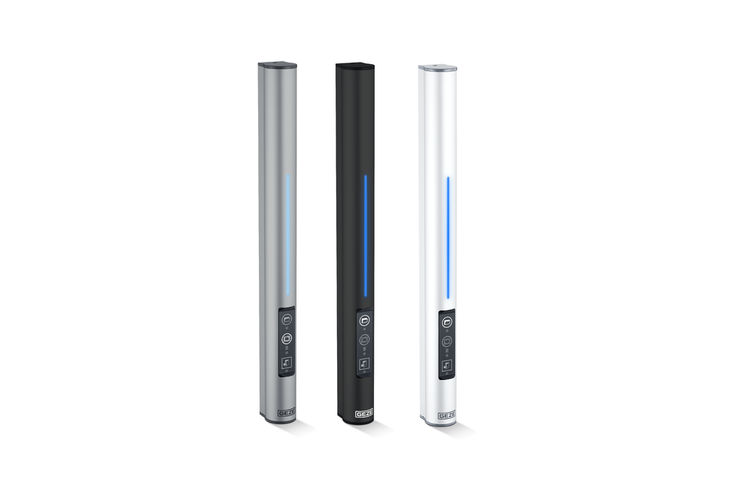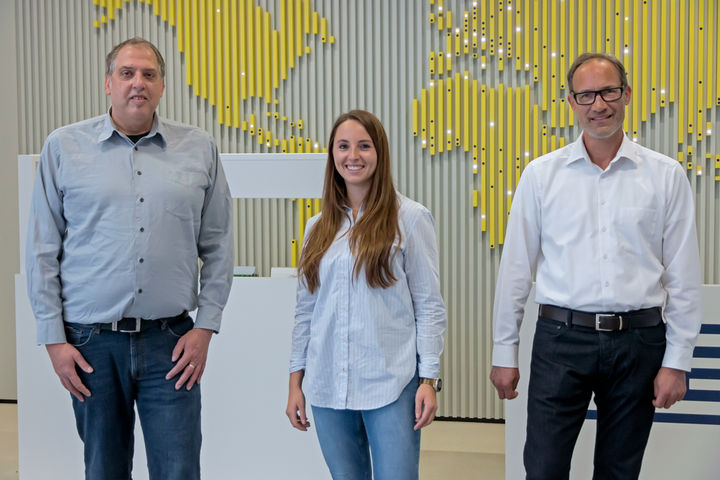Expert discussion: Development and advantages of the new F 1200+
GEZE solutions are always focused consistently on the needs of architects, planners, installation companies, operators, and users. This focus on the customer was also essential to us in the development of the F 1200+ ventilation drive. In an interview, Product Manager Dawina Lebsanft, Development Engineer Manfred Glänzer, and Konrad Specht, Team Leader of Window Development, explain how the new window drive was created, what it can do, and why it greatly simplifies the operation of room-height windows – making it the ideal drive for modern, sustainable façade design.
Even at first glance, the F 1200+ leaves a very high-quality, aesthetic impression. What aspects were important to you with regard to the design?

The shapely F 1200+ is available in any RAL colour and can thus be matched exactly to the existing profile in the building.
Dawina Lebsanft: Most GEZE products are designed to be integrated into the architecture as discreetly as possible. The F 1200+ is different. The drive was intended to be seen on the window as an aesthetic operating element, and above all to be comfortable, ergonomic, and intuitive for users to operate and handle. In addition to fulfilling its purpose as a window drive, the F 1200+ also serves as an operating element and handle to easily move the window manually to the turning position.
Manfred Glänzer: Exactly; that is why the drive is ergonomically shaped, with a curve on the front and tapered at the back.
Konrad Specht: We also chose to use high-quality materials. In addition, the F 1200+ is available in different colours to match the leaf profile of the window or façade.
What are the unique strengths and benefits of the new F 1200+?
D.L.: Well, firstly certainly in terms of the application itself, since the F 1200+ is the first automated drive from GEZE for particularly large and heavy turn-and-tilt windows. However, it can naturally also be used to operate larger standard windows or even casement doors easily, securely, and quietly, such as those found on balconies in residential construction. In general, the new window drive is primarily directed towards customers who want to equip an entire building with multiple storeys.
M.G.: One very special thing about the F 1200+ is its capability to block the swinging of the window, to allow for tilting only. Our drive even offers two options for doing so: via the software or mechanically using a lock on the drive. Imagine a public building, for instance; to ensure user and building safety, the windows should only tilt, and not be opened completely. However, when the cleaning company comes, the facility manager or building manager can easily release the turning function using a key.
D.L.: In addition, the window drive has an intuitive operating concept. This allows the drive to guide the user through operation, and even illuminates only the push buttons currently available for the specific window state. For example, this prevents the tilted window from being simultaneously opened in turning position, and from accidentally becoming unhooked.
Our opening indicator is completely novel on the window drive market: The LED display visually displays to me how far I have opened my window. Naturally, it also indicates whether the window is once again closed completely.
Konrad Specht, Team Leader of Window Development
Proximity and brightness sensors ensure that the illumination of the buttons is displayed at the right moment and with the appropriate brightness. © GEZE GmbH
With regard to “Smart Building” – what does the F 1200+ offer?
D.L: Via the IQ box KNX, the ventilation drive can be integrated very easily into a building management system. This allows the windows to be controlled centrally. The LED display also indicates activation via the building management technology or other status reports. If the display is illuminated light blue, this means the drive is being operated by a user directly via the push buttons. If the display is dark blue, the window drive is currently being centrally activated.
K.S: Opening and closing are carried out almost silently. The F 1200+ is the quietest window drive GEZE currently offers – despite the power necessary to move large and heavy windows. The drive is whisper quiet at 38 decibels when in automatic mode.
D.L.: Thanks to integration into the building management technology, windows equipped with the F 1200+ can be opened or closed automatically at a certain time, or by wind and rain sensors. This allows building operators to save money: Imagine it will be 35 degrees Celsius again tomorrow. In this case, you could automatically tilt the windows the night before in order to cool the building down in advance via natural ventilation; no one would have to turn on the air conditioning first thing in the morning.
M.G.: If the power does go out at some point, our drive always offers the option of manually closing the windows using an Allen key.
Does the F 1200+ also support building accessibility?
D.L.: Yes, the aspect of barrier-free use of windows with the F 1200+ was very important to us. The F 1200+ can be mounted both vertically and horizontally. That means you have the flexibility of placing the drive so that people in a wheelchair can operate it easily.
All product details for the F 1200+
How did the project to develop this kind of window drive come about?
K.S.: The project originated from a specific customer need. An operator already equipped four or five thousand windows with our mechanical F 1200 window fitting several years ago. During a full renovation, the operator wanted to be able to automate these windows somehow. Of course, we took on this challenge and created a custom solution based on our GEZE Power lock locking drive. That inquiry got everything moving.
The customer inquiry and the project showed us that we needed to add to our product portfolio. The F 1200 was and remains very successful, but the trend is to automate large, room-height windows. This is simply a good argument for a motorised solution that is comfortable, intuitive, and safe to operate.
Dawina Lebsanft, Window Technology Product Manager
Yes, and what was the development process then?
D.L.: Before we start a development project, we carry out a market analysis in product management. We carefully coordinate such analyses with our international sales team. That was the case for the F 1200+ as well. Firstly, we needed detailed information on whether there was a need for such a solution among our customers – both national and international. The analysed stipulations and information are collected and prepared in a requirements specification.
M.G.: Yes, this process is very important. It precisely defines what the new F 1200+ needs to be able to do. The actual development process was then started from this basis. We began by translating the stipulations into concepts. For example, the drive needed to be able to “communicate” with the user, and operation needed to be absolutely intuitive.

The F 1200+ was developed with a consistent focus on the needs of its user groups – including internationally. © GEZE GmbH

Modern façade design calls for floor-to-ceiling window elements that create maximum daylight and comfort in indoor areas. The F 1200 is the ideal window fitting for this trend, and can be used to operate large and heavy turn-and-tilt windows. © GEZE GmbH
And was the next step to create a prototype based on this?
K.S.: Exactly. Of course, you can’t think of this as a finished product. Like most other products, we assembled individual assemblies and components of the F 1200+ as prototypes.
D.L.: We then also used these prototypes to conduct usability tests. These analysed the operation and use of the functions, and asked test users relevant questions, such as: “Do you know what you need to do?” or “What do you think of the size and brightness of the display?” The findings from these tests were very helpful for ongoing development. I thought it was interesting how testers operated, analysed, and perceived the drive. Based on this feedback, we tinkered with the operation until we had the best possible handling for our window drive.
M.G.: Yes, and in addition we looked far beyond the horizons of this individual project, for instance to operation of coffee makers. We took a look at them and compared: What buttons light up, how do they guide the user, what is the interaction between an operator and the product? So many different products and applications served as inspiration and gave us ideas.
In some cases, we looked far beyond the horizons of this individual project in the usability tests, and compared: How is the user guided, what is the interaction between an operator and the product? So many different products and applications served as inspiration and gave us ideas.
Manfred Glänzer, Window Technology Development EngineerHow did you then move from prototype to series product?
K.S.: It's still quite a long way from the prototype phase to a series product. Before industrialisation, the F 1200+ was first fully assembled during the so-called B sample validation phase. This allowed us to thoroughly test the functional drive on real windows. During this phase, the focus is also on fulfilling the standards set forth in the requirements specification. This was fairly challenging, as the F 1200+ also needed to fulfil all international standards so that we could serve all of our markets with one product. We achieved this goal as well.
D.L.: Yes, we developed a product that we are very proud of ... Now, we are glad the drive is available to automate large windows and therefore help design modern façades.
Ms Lebsanft, Mr Specht, Mr Glänzer – thank you very much for speaking with us!


